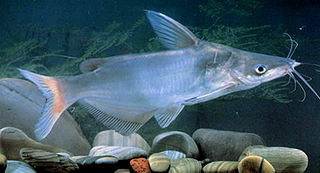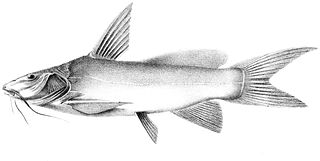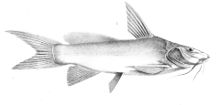
Catfish are a diverse group of ray-finned fish. Named for their prominent barbels, which resemble a cat's whiskers, catfish range in size and behavior from the three largest species alive, the Mekong giant catfish from Southeast Asia, the wels catfish of Eurasia, and the piraíba of South America, to detritivores, and even to a tiny parasitic species commonly called the candiru, Vandellia cirrhosa. Neither the armour-plated types nor the naked types have scales. Despite their name, not all catfish have prominent barbels or "whiskers". Members of the Siluriformes order are defined by features of the skull and swimbladder. Catfish are of considerable commercial importance; many of the larger species are farmed or fished for food. Many of the smaller species, particularly the genus Corydoras, are important in the aquarium hobby. Many catfish are nocturnal, but others are crepuscular or diurnal.

Trichomycteridae is a family of catfishes commonly known as pencil catfishes or parasitic catfishes. This family includes the candiru fish, feared by some people for its alleged habit of entering into the urethra of humans. They are one of the few parasitic chordates. Another species is the life monsefuano which was important to the Moche culture and still an important part of Peruvian cuisine.

The Aspredinidae are a small South American family of catfishes also known as the banjo catfishes, with about 43 species.

The Ariidae or ariid catfish are a family of catfish that mainly live in marine waters with many freshwater and brackish water species. They are found worldwide in tropical to warm temperate zones. The family includes about 143 species.

Sisoridae is a family of catfishes. These Asian catfishes live in fast-moving waters and often have adaptations that allow them to adhere to objects in their habitats. The family includes about 235 species.

Erethistidae are a family of catfishes that originate from southern Asia. It includes about 45 species.
The Chiapas catfish, Lacantunia enigmatica, is an unusual species of catfish from the Usumacinta River basin in the Mexican state of Chiapas and in Guatemala. It was scientifically described in 2005 and placed in its own family Lacantuniidae. While discovery of an undescribed species of catfish is not uncommon, discovery of a new family of any vertebrate group is a rare event. The Chiapas catfish mainly feeds on crabs, prawns, small fish, and large, tough plant seeds. This catfish is commonly fished in its natural habitat, where it is known as madre de juil, which means "mother of Rhamdia".

Akysis is the largest genus of catfishes of the family Akysidae.

Cranoglanis is the only genus of armorhead catfishes.

Horabagrus is a genus of catfish in the family Horabagridae endemic to rivers in the Western Ghats in Kerala and Karnataka, India. H. brachysoma is an important food fish and members of this genus can be found in the aquarium trade.

Ancharius, the Vaonas, is a small genus of catfishes of the family Anchariidae.
Gogo is a small genus of catfishes of the family Anchariidae. It includes four species.
Pseudobagarius is a genus of catfishes of the family Akysidae.

Galeichthys is a genus of sea catfishes in the family Ariidae, the only genus in the subfamily Galeichthyinae. It includes four predominantly marine species distributed in Southern Africa and northwestern South America:

Batrachocephalus mino, the beardless sea catfish, is the only species of catfish in the genus Batrachocephalus of the family Ariidae. This species occurs in marine and brackish waters of Bay of Bengal, and parts of the western central Pacific, in coastal waters, estuaries, and lower reaches of rivers. It is distributed from Pakistan, India, Sri Lanka, Bangladesh, Myanmar, Malaysia, Thailand, to Indonesia.

Ketengus typus, the bigmouth sea-catfish, is the only species in the sea catfish genus Ketengus.
Ancharius griseus is a species of catfish of family Anchariidae. It inhabits the Onilahy River basin of western Madagascar. A. griseus reaches about 24.4 cm (9.6 in) SL.
Gogo arcuatus is a species of catfish of the family Anchariidae endemic to Madagascar where it is found in the Sandrananta River basin. It grows to a length of 18.1 cm.
Gogo brevibarbis is a species of catfish in the family Anchariidae. It is commonly referred to as the vaona though this name also refers to Ancharius fuscus. It is endemic to Madagascar where it is only known from the holotype, which is apparently from the Mananjary River basin. Its natural habitat is rivers. It is threatened by habitat loss. It grows to a length of 25 cm.
Gogo ornatus is a species of catfish of the family Anchariidae endemic to Madagascar where it is found in the Mangoro River basin. It reaches a length of 21.2 cm.













